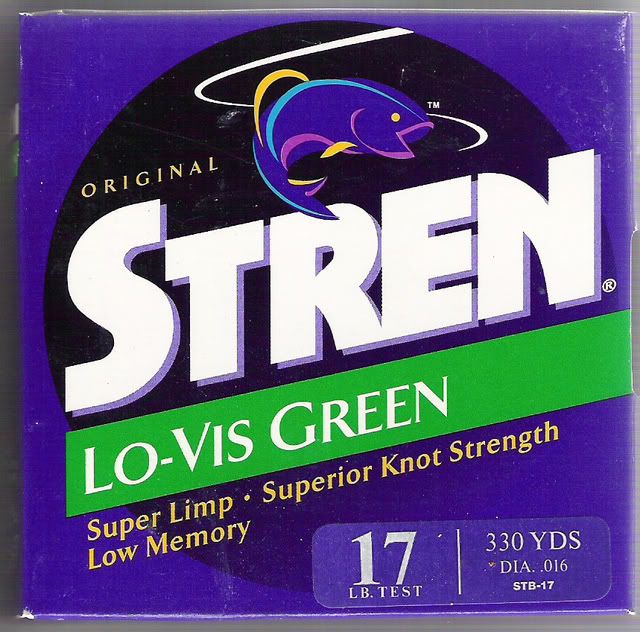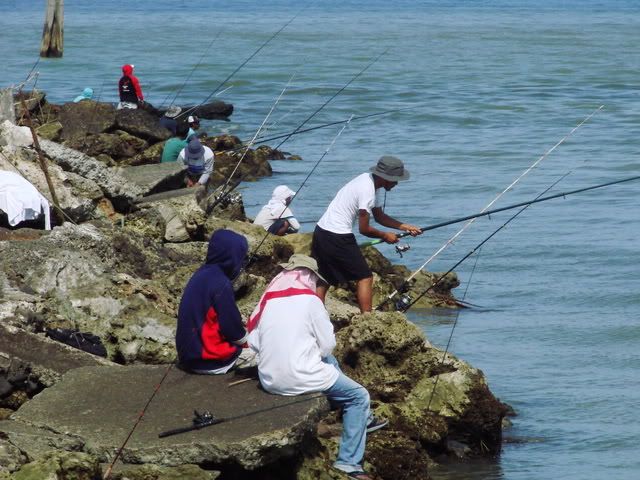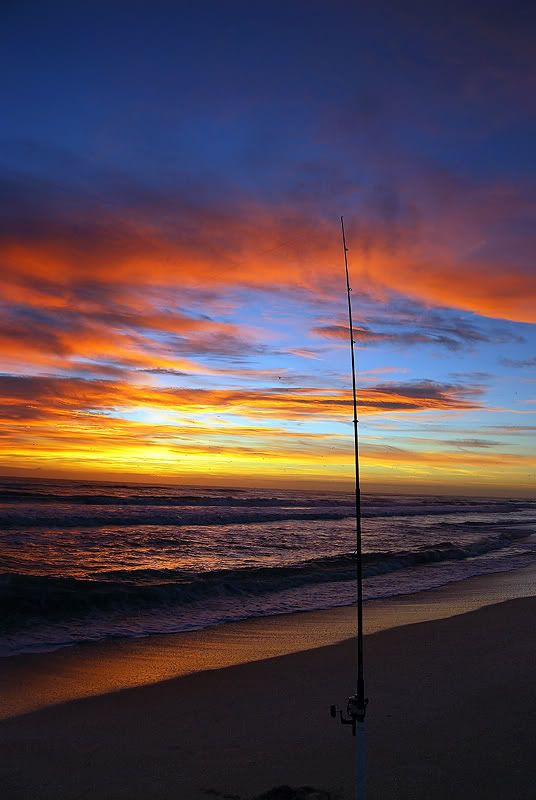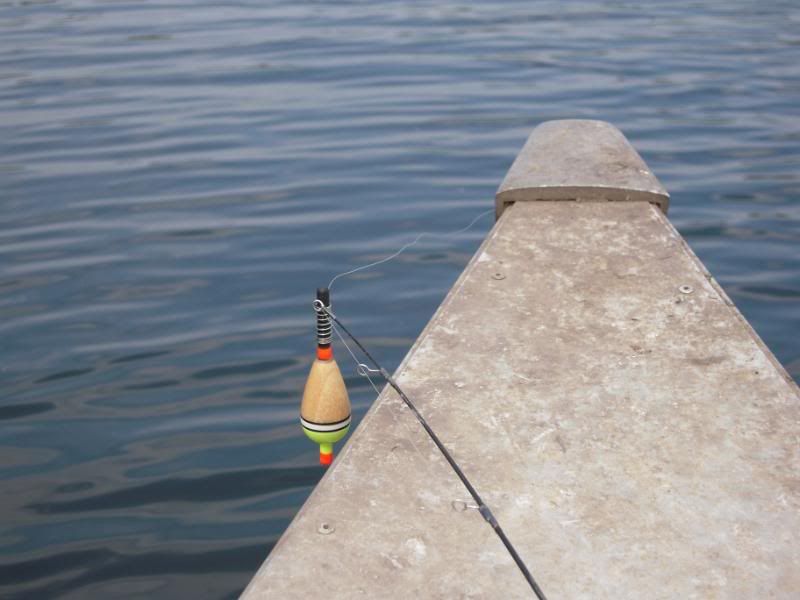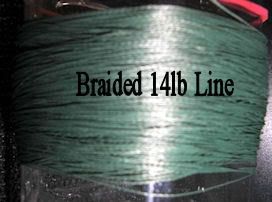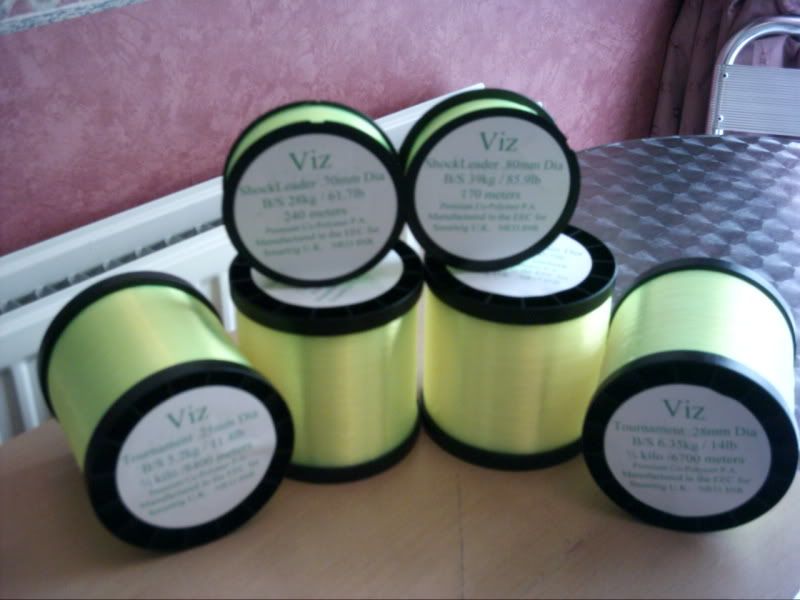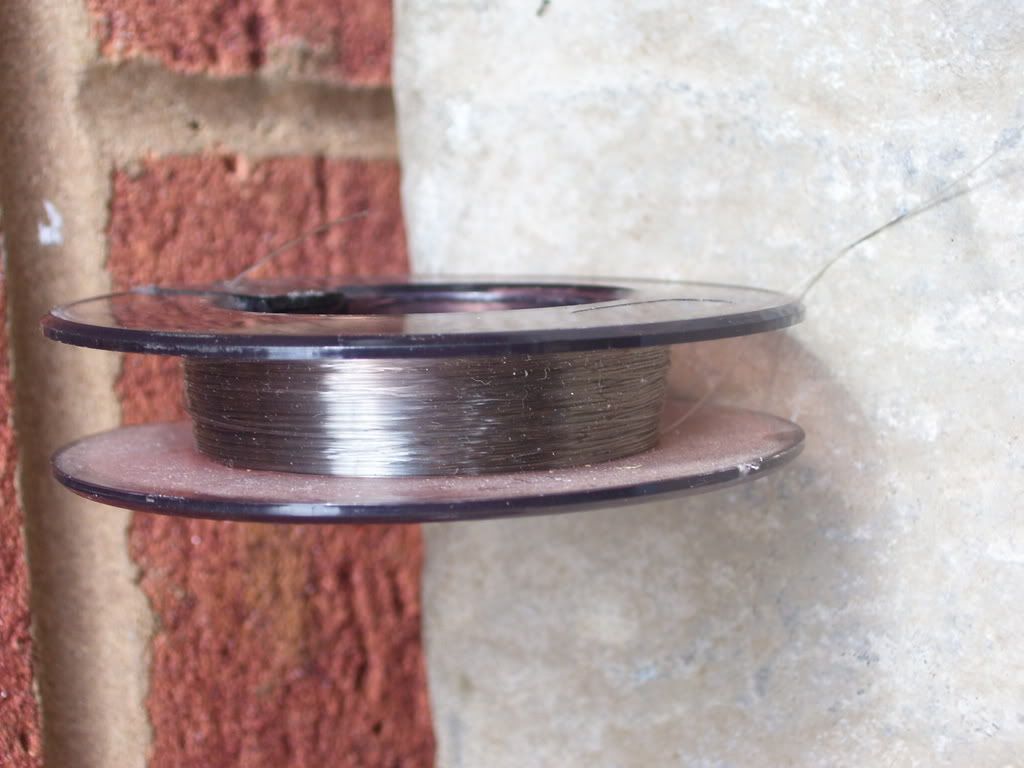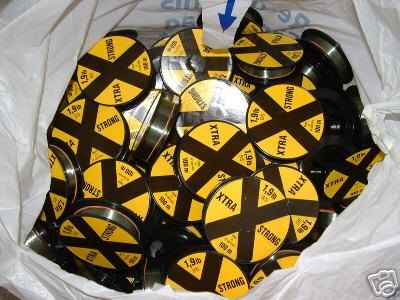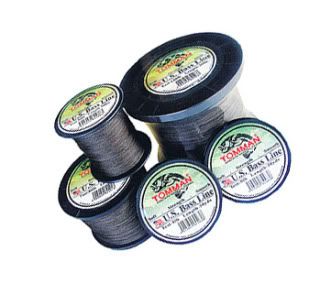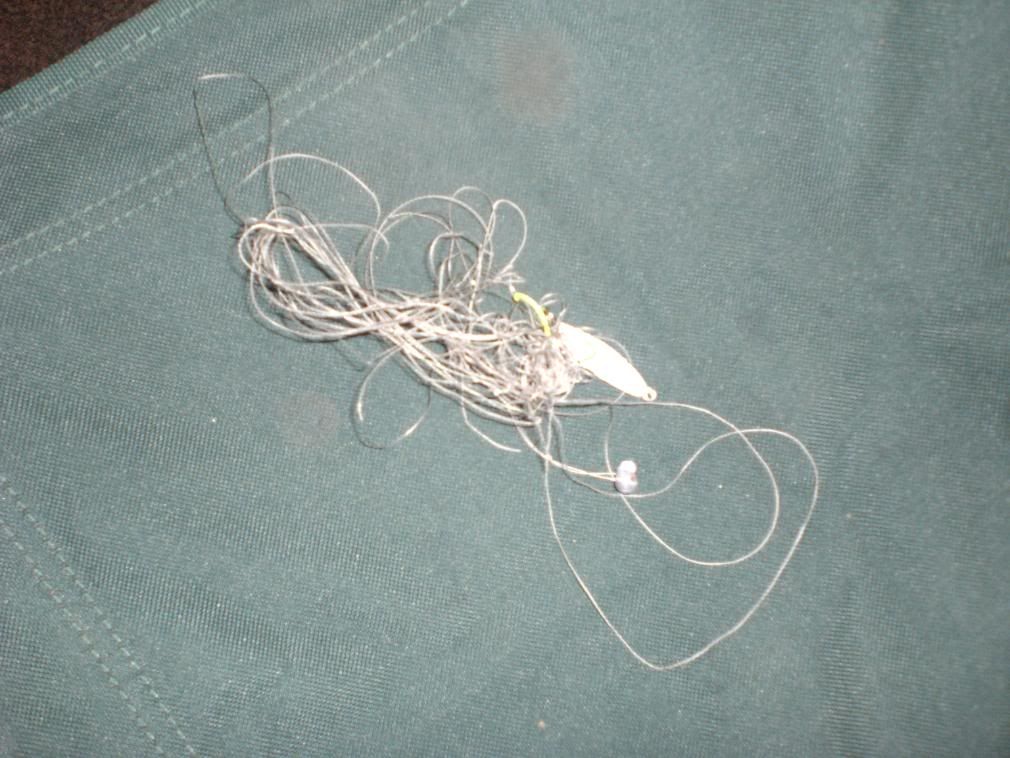Prospective fishermen must have an idea of the fish they want to catch. This factor will normally give an idea of the average size of the fish. Fishing lines are made thicker for the heavier fish (the weight of the fish in comparison to the line is referred to as pound test.) However, from experience, I can attest that they can hold more weight than what is printed on the package. And, from personal experience, the more of a fight the fish puts up the more fun to catch them. However, you have options for how the line is made. Here it is:
Monofilament line is made of a single fiber. It is very low cost and comes in different colors. It does not offer a lot of UV protection from the sun and it can absorb water which either together or separate, these factors contribute to the line's integrity deteriorating. Most knots can be tied with monofilament line.
Multifilament line is comparable to monofilament line but is braided for additional strength. It does cost more than monofilament line. Palomar knots are one of the best knots to use with multifilament line because of the fine braids in the line. It can be up to ten times sturdier than steel by weight.
Braided line is a thicker line. Historically, it is made of natural fibers. However, today it is made with synthetic fibers. It has a high rate of endurance against breakage. Be aware in the water it is opaque, thus the visibility is high to the fish.
Power Pro fishing line is about 20% of the thickness of multifilament line. It has more feel to it when catching a fish and a better rate of securing the fish on the hook with the jerk of the pole. It is a little pricier than multifilament line.
Remember, that on the reel the lines can be used single or in combination form of these lines.
Different Types of Rod for Different Fishing Techniques
Fishing may seem quite straightforward to the novice, from the outside, it may appear that all that a person needs is a stick, some string, and a bit of food, throw that in the water and catch a fish - simple!
Not so, there are many different styles of fishing, all making use of complex technologies that have been years in the making. For each fishing style, there are different tools - or fishing tackle, to use the correct terminology - understanding a little about the various types of equipment used in different forms of fishing is essential. Here we will discuss one of the most important pieces of equipment, the fishing rod.
The fishing rod is clearly essential when trying to catch fish - except in the case of commercial fishing, which makes use of industrial nets instead. Fishing rods come in a variety of different styles, depending on the type of fishing the angler practices, as well as their skill level. The length of the poles varies depending on the style of fishing, but they are generally between 1m and 5m long - and this depends largely on the distance needed to project the line into the water, anglers call this casting. To the fishing rod, we add a fishing line, which is secured along the rod, and let in and out by the reel; a hook, bait, or lure, are added to the end of the line - and this is the part of the fishing tackle that induces the fish to bite.
There are different types of fishing rod used for different types of fishing. In the UK, coarse fishing is a popular hobby. The sport of coarse fishing refers to freshwater fishing, in which anglers hunt for fish besides game fish - game fish include salmon and trout.
In coarse fishing, it is common to find carbon fibre rods. Carbon fibre comes in a variety of different qualities, and the price of fishing rods reflects this. It is usual for the most avid of anglers to spend upwards of £2000 on a decent carbon fibre rod. However, as a beginner, you should not be spending more than £200. The length of carbon fibre rods varies depending on the skill level of the angler, as well as on the distance needed to cast. Carbon fibre rods are lightweight, and this helps with positioning the bait in the water, casting is more accurate with a carbon fibre rod.
Next, we have fishing rods anglers use in sea fishing. Sea rods tend to be longer, heavier and thicker; anglers need weightier tackle to ensure that the bait and lure can sink to the necessary depths; salt water is denser, thus needing more force to penetrate. The most frequently seen sea rods in the UK are surfcasting rods; these are generally a lot longer than other forms of fishing rod as they need to be able to cast beyond the breaking surf.
How to Choose the Right Fishing Line
If you need new fly fishing line, or want to make sure that you've got the right line no matter what you're fishing for, then here's what you need to think about.
1. You'll want to establish what sort of fish you'll be catching with your new line. Will you be sea fishing? Will you be catching salmon or trout? Will you be fishing abroad, and be catching different fish to what you're used to here?
2. Knowing where you'll be fishing can help too. If you regularly fish the same spots, you'll know what sort of fish are to be found there, and how big they are. This will help you to determine what size and strength of fishing line you'll need.
3. How often you fish will also help you determine what line will be best for you. If you're only going to be fishing a few times a year using this line, then you're not going to get the same use out of it as if you were going to use it on your main rod, which you use every weekend.
4. Monofilament is probably the most common sort of line and is suitable for most environments. You might want a stronger line, such as an extra taut one if you're going to be standing in a river in your waders, and will be facing rough environments with rocks and other obstacles.
5. It's important that your chosen fishing line is easy to knot, and that you can do it at home, and with cold hands on the river bank. If your knots slip, or are hard to tie, then it can mean that you don't catch as many fish as you'd hoped.
6. The colour of your fishing line is important. You don want the line to be visible to the fish. When fishing in clear water, you'll need a clearline, but you'll want some coloured lines for when you're fishing in murky waters, and a clear line would stand out.
7. If you're confused by all the different sorts of lines, then why not see what lines other anglers use where you fish? They'll have their reasons, and their favourites, and be able to give you advice on what will work for you.
8. The length of your line is something to think about too. If your line is too long, then you'll be carrying extra unnecessary weight. If your line is too short, you might struggle to catch anything.
9. There are many brands of fishing lines to choose from, and you might have your favourites, or want to try something different this time. It's much better to choose the right line, rather than worrying about which brand to choose.
10. No matter what sort of fishing line you buy, you'll want value for money. There's no point in buying a cheap line that you'll never use, or compromising by choosing a lesser line in order to save a little bit of money.
Now you know what to look for, and what's important, you'll be able to choose the right fishing line.
Basic Fishing Equipment - Beginner's Guide
Be it a warm summer morning or a cold wintry afternoon, you can never fail to see a fishing line or two while passing a lake or a stream. Fishing is a habit close to addiction for those who have the flair and skill for it. Ask any seasoned angler what it takes to land up with a good catch and he'll promptly tell you that it is sheer instinct and logic mixed with basic common sense. With a lot of practice and experience, you get to know which rod and reel is best suited with which line and in what kind of rig. Matching all the fishing tools properly goes a long way in making a fishing experience both enjoyable and productive.
Now let us go through the checklist of fishing equipment for the benefit of beginners. The list includes the following basic tools:
- Fishing rod
- Hook
- Line
- Reel
- Float/bobber
- Sinker
- Lure
Before getting into the nitty-gritty of the best combination of the above-mentioned equipment for good fishing experience, let us discuss briefly the different varieties of each tool available in the market.
Fishing rod:
In modern times, a fishing rod is manufactured to allow the angler to feel the bite of fish. The rod shaft is termed as blank. The blank is usually made of graphite, fiberglass, or other material depending upon its actions. The action of these blanks can be light, medium, medium-heavy, and heavy. The actions of the tip of the blank are called regular, light, and extra light. When the guides and handles have been assembled onto the blank, we get a complete fishing rod. Depending on the type of fish you are out to catch, you can choose a rod based on its blank. Most of the new graphite rods are light in weight and are balanced at the reel seat (i.e., when you set the rod handle on your finger with the reel attached, the rod should balance equally from tip to the end of the handle). The guides (or eyes) fitted on the rod help in transmitting signals to the rod so that the angler can feel the fish biting on the bait. The guides should be clean and in prim condition to allow optimum performance of the rod.
When choosing handle length, think of your comfort level. If you are on high ground, then a 7-foot rod can be a good choice so that you can cast farther. However, if the ground is low, then a shorter rod will make it easier for you to flip, cast and spoon fish.
For bass fishing, light action rods are a definite no-no as it takes some effort to pull a bass out whereas for small bait-fish, you need an extra fast action blank tip to prevent the fish from making desperate movements. Hence it is clear that you must choose your rod based on your catch.
Hook:
Hooks are needed to allow the angler to use the bait and help the bait to stay on longer, thus increasing potential chance of a catch. Hooks can be chosen according to the size of the fish from juvenile to adulthood. Hooks come in a wide variety of colours, metal treatments and finishes. Some are better suited for salt-water applications while others perform well in freshwater. There are certain hooks that are invisible under certain light conditions whilst differences in water colour and distinct clarity may be the requirement for other types of hooks.
The most popular and widely used varieties of hooks are:
Octopus hook - Most common, it is an octopus-like strong tapered shank hook with a turned up tapered eye, wide open mouth and moderate depth throat. The curved-in point in this pattern is extremely sharp and penetrates readily. Mostly used for snappers.
Long shank hook - This has a kerbed parabolic bend, shallow bite, either a short curved-in point or a modified hollow point. This is used in case of fast-biting fish and ideal for kids to handle.
We guarantee much better fishing results. Check out this new revolutionary invention and get ahead of your fishing friends. Buy the Award Winning 'Esca Lures' online at http://www.escalure.co.uk/
Circle hook pattern - This one commonly has an extra strong forged shaft with a wide circular or squared-off bend narrowing to an exaggerated re-entrant point. This has a deep penetration point. This is very popular amongst game fishers.
Ganging hook - This usually has the turned down, open eye Kendall Kirby pattern with a medium length flexibly formed wire shaft, in sizes ranging from 1/0 to 6/0. The open eye is intended to be used to combine two or three ganging hooks to form a ganged set depending on the size of bait. The ganging hook is ideal for whole baits like garfish and when the bait is being smashed against rocky terrain.
Southern and tuna hook - This is heavily forged with the rod tapering to a brazed ring and the circular bend with its knife edge point drawn inwards toward the rod. This type of hook, once lodged into the mouth of a fish is difficult to dislodge. This is popular with game fishers.
Line:
From the anciently used piece of cotton string, fishing lines have evolved to a much fancier version in the present day. Braided lines are still sometimes used in saltwater for big fish, but most anglers use monofilament lines called the new super lines. Monofilament comes in basically two types - a flexible, or limp, line that has some stretch, but seldom recoils or snaps when cast and left on the reel for a long time. The other is more abrasion resistant, less stretch and usually retains some memory and tends to hold a coil when it's been on the reel for a while, thus increasing the chance of a backlash.
Braided line has a smaller diameter compared to monofilament for the same line size and is generally not taut. It is used for flipping (placing the bait quietly in a given spot using an underhand cast, without disturbing the water, while holding the rod with the other hand)and pitching (putting worms or jigs into cover at close distances using underhand pendulum motion) where high strength and good abrasion resistance is needed.
In case of bream fishing, a light-weight line of 4-8 pounds will suffice whereas with bass fishing, 6-12 pounds (or even 12-24 pounds) is required. Tying a good knot in the line to hold the hook is essential. The basic knots used by anglers are: Clinch, Palomar (simple knot for terminal tackle), Uni (also known as the Hangman's knot) and Loop (can be easily tied at night with minimum effort).
Reel:
Reels have come a long way from the old direct drive, sleeve-bearing to the sophisticated ones found in modern times. They come in four basic types, the simplest of them being the closed-face spinning reel, which is operated by a push button and helps protect against getting tangled when you cast the rod. Next comes the open-face spinning reel which helps in casting the line a little further. The size of the reel depends upon the weight of fishing line. Another reel type is the bait-casting reel. These reels have some kind of a braking system, (either magnetic or centrifugal) to help slow the spool and control backlash problems. The more the number of ball or needle bearings in the reel, the more costly it turns out to be. The fourth type of reel is the fly-fishing reel. A fly reel is not cast, and is mainly a place to store the line and keep it free from tangles. Line is pulled from the reel, and the rod is waved overhead to work the line out.
Float/bobber:
Floats are used by anglers for two distinct purposes - to insert the bait at the surface or a specific depth under the water level, and as a bait indicator showing whether the fish is at the bait or not, allowing the angler to know when to strike and set the hook. They can be used for both fresh-water as well as salt-water experiences. Floats come in a wide shapes and sizes with different levels of buoyancy.
Some commonly used varieties of floats include: bobby cork and casting float (used for casting large baits over greater distance. Provide minimum wind resistance and sits on water with stability. Used by land-based anglers and sport anglers); bubble float (clear plastic float used for freshwater fishing in clear, least turbulent water); pencil float (a centre spindle pierced through the center of a cork, this can be used as a fixed float at a predetermined depth or as a running float at an adjustable depth. Provides minimum resistance to the fish when biting at the bait, so angler can time the strike to set the hook); quill float (it is very long, narrow and incredibly light consisting of attachment clips and snaps. Being light, fish feels no resistance from surface while taking the bait and the angler can take time to strike to set the hook); cork and homemade float (cork being inexpensive, tough and featuring the flexibility to be cut into various shapes and sizes makes it ideal for using it to make homemade floats).
Sinker:
The primary utility of a sinker is to present and hold the bait or lure at a particular depth beneath the surface of water. The various types of sinkers are: ball, barrel, bean, split shot, snapper lead, tear drop, star, and spoon (used for ease of retrieve of fish).
The ball, barrel, and bean sinkers are mainly designed to allow a degree of movement. These types of sinkers can be used in all kinds of water, still or turbulent. Whether at the bottom of the water surface or at mid-water, a fish can move off with them without feeling the weight of the line.
Split shot sinkers are similar to ball sinkers, but mostly used in calm or least turbulent water. These sinkers can be used with different weighing configurations. Split shots can be used for catching small finicky fish feeding at particular depths with a lot of ease.
Snapper leads and tear drop sinkers are mainly used for deep-sea fishing with heavier lines. These provide the advantage of holding the bait vertically even in strong currents. They are also used as surf casting sinkers.
Star sinkers are primarily used for surf, beaches and estuary usage supporting moderate to heavy lines. These sinkers provide great horizontal stability to the baits due to their star- pyramid shape and heavy bodies. These can be used in strong currents.
Lure/flies:
Lures are colourful, artificial plastics or metal shapes used to attract the attention of the fish by simulating the look and movement of their natural prey, to fool them into believing these can be eaten, or even to challenge their territorial instincts. Lures are available in various shapes, sizes and colours catering to the various needs of an angler. The common lures are - minnow types (look like small fish with metal or plastic bib, Ideal for nearly all casting and trolling purposes), soft and scented plastics, metal lures and slices (heavy replicas of bait-fish, ideal for fishing off beaches and rocks), surface poppers (cigar-shaped, suitable for surf, trolling and estuary usage), skirted trolling lures (designed to be tough and used for salt water game-fishing), jigs (heavy-weight fast sinking lure meant for lifting and dropping the lure repeatedly by hand or by rod and wind action from the side of a boat or jetty. They are useful for catching tuna, mackerel and kingfish), squid jigs (squids used as baits for catching snapper or gummy sharks), celtas and insect spinners (for fresh-water fish like trout and red fin).
Flies are used for replicating natural behaviour of aquatic insects on which fish feed in water and with their subtle movement and placement, can be used to trick the fish to rush towards the bait or to challenge their natural territory. Different types of flies and aquatic insects have their habitats at different levels of water. Depending on which fish feeds on what type of insects, flies can be presented as live baits at that level of water column to bait that particular variety of fish. Flies can be categorized into wet fly, dry fly, Matuka and salt water fly collections depending on the surface they can be located at.
Finally for the beginner, the affordable and least complicated combination of fishing equipment would be a Zebco 33 rod and reel package. It comes with a 10-pound line meant for most small and medium sized fish. The other basic tackle that'll be required are - size #6 or #8 live bait hooks, a couple of crappie rigs, a few 1/4-ounce and 3/8-ounce bell sinkers, a small cork or float. For a less messy experience, you could stock up the following artificial tackles - a package of 1/0 offset worm hooks, some 3/16-ounce bullet worm weights and a package of 4-inch watermelon and pumpkinseed Venom worms called Slammers, one or two 1/8-ounce shad pattern spinner baits and a couple of 1/4-ounce chrome/blue back lipless crank baits. For crappie, perch and sand bass, you need a few small white and bright yellowish-green jig hooks with the same color small grubs (short plastic worms). These tools will not be too expensive, but will be enough for the basic tackle to lure a wide variety of species.
Getting the right combination of equipment and choice of bait comes with practice and experience, and as you try your luck with a variety of fish in different weather conditions and seasons, you can soon master this skill. Until then happy fishing!
Experience Deep Sea Fishing in South Africa
My first ever trip deep sea fishing in South Africa starts with an early morning wake up call at 5.00am. I am staying at lovely guest house accommodation in Port Alfred situated on the coast of the Eastern Cape. With a sense of excitement I kick start my day with a strong coffee and prepare food to take with me for what I hope will be a successful days fishing. The night before I took some Sturgeon (seasickness tablets) just to be on the safe side as I am not sure what the Indian Ocean has in store for me. We make our way down to the boat and prepare everything. We have taken 2 boxes of fresh sardines for bait.
Port Alfred has a lovely marina with a river that flows into the Ocean. We have timed our exit from the Kowie River mouth to coincide with low tide to ensure we have the smoothest exit to the Ocean. Nevertheless we put on our life jackets and ride the waves at the river mouth out to the vast Indian Ocean. We are riding in a Butt Cat which is superb for the Ocean with the ability to ride over the oncoming waves. Our skipper is Des, an experienced fisherman who knows the waters off this area of the Eastern Cape, and asks us to hold on as he picks up speed crashing over the waves in front of us. This is great and a really exciting start to the day completely taking my mind off any potential seasickness.
We head out for about 30 minutes before we drop our first anchor. Once we are settled we start to bait up our rods and drop our first lines. There are three of us on the boat so Des gives us expert advice on how to bait up and some tips on what to do when you get your first nibble on the line. I can't believe how far down my line goes before my weight hits the bottom! As soon as my line reaches the bottom of the Indian Ocean I can feel the fish biting. This is amazing I didn't expect to feel the bites so firmly. I know try and put into practice Des' tips on making a strike. After a few fruitless attempts I make a proper strike and I reel in quickly.
Of course it's a long way up and my arms are doing all the work but soon I can see the fish on the end of my line. The feeling is amazing! Des shows me how to bring the fish on board and then how to remove the hook from the fish. The fish is too small to keep but the taste of the catch has left me wanting more. Having returned the fish to the Ocean I bait up again. We spend about an hour in the first spot before moving on to a new spot. The Ocean is relatively calm and the weather is superb - always remember your suntan cream as the breeze out here can be very deceiving.
We stop for lunch halfway through the day to enjoy homemade sandwiches and cool drinks. Bobbing around on the Ocean we suddenly hear the noise of a familiar spurt of water made by a whale. Des points out the southern right whale about 600 meters away - incredible to think these mammals are cruising around near where you are fishing. We finish lunch and move on to a new spot. We enjoy in total about 8 hours fishing and catch enough good size fish for dinner later that evening. During the afternoon we spot lots of white water about a mile away from us - Des heads his boat towards the area and we are suddenly surrounded by 1,000's of dolphins as far as the eye can see. This is an incredible sight and I take lots of photos to capture the moment.
As we return back to Port Alfred I look back on an amazing first experience of deep sea fishing in South Africa. South Africa has miles of coastline with a great choice of accommodation to be found from Guest Houses, Bed & Breakfasts, Lodges and Self Catering venues. From Cape Town all the way up the Garden Route to beyond Durban there are numerous beach holiday places to stay where you can take a fishing boat charter.
We guarantee much better fishing results. Check out this new revolutionary invention and get ahead of your fishing friends. Buy the Award Winning 'Esca Lures' online at http://www.innovativefishingtackle.co.uk/




